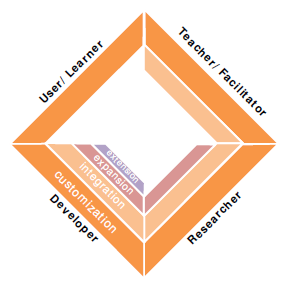Tailorability
Definition
Tailorability or appropriation or malleability refers to capability of an artifact (e.g. a pedagogical text or a tool) of being adapted to a given purpose or function
Appropriation (or tailorability): how an individual or group adapts a technology to their own particular situation; the technology may be appropriated in a manner completely unintended by the designers. Wikipedia, retrieved 13:53, 12 January 2009 (UTC).
CoFFEE model
De Chiara (2007) defined four kinds or levels of tailorability. We call it the CoFFEE model since it has been discussed for the design of the CSCL software of the same name ....
- Tailorability by Customisation: it is the simplest form of UC tailorability; it allows to configure the basic properties of a groupware, in such a way to slightly modify the behavior of a functionality.
- Tailorability by Integration (or Composability): it allows the user to select the desired functionalities (tools) from a predefied set that is given within the system.
- Tailorability by Expansion: the user is empowered to widen the set of available functionalities by adding new, compatible tools to the system.
- Tailorability by Extension (or Extensibility): it allows the user to add new components from third parties in the groupware without changing the existing components. This requires open standards for interoperability.
CoFFEE: Cooperative Face2Face Educational Environment, retrieved 13:53, 12 January 2009 (UTC).
The authors argue that different kinds of users need different levels: “The user/learner needs only the configurability of the system (Tailorability by Customisation), the teacher/facilitator needs the Tailorability by Integration, the researcher requires to expand the fixed set of tool with new additional services/ tools (Tailorability by Expansion) and, finally, the developer is entitled to the full tailorability that can be offered, by extending the system with newly designed tools (Tailorability by Extension).”

Links
- Computer supported cooperative work (Wikipedia)
Bibliography
- De Chiara, R., Di Matteo, A., Manno, I., Scarano, V. (2007), CoFFEE: Cooperative Face2Face Educational Environment, in Proceedings of the 3rd International Conference on Collaborative Computing: Networking, Applications and Worksharing (CollaborateCom 2007), New York, USA, November 12-15, 2007.PDF
- Dimitracopoulou. A (2005). Designing collaborative learning systems: current trends & future research agenda. In CSCL '05: Proceedings of th 2005 conference on Computer support for collaborative learning, pages 115-124. International Society of the Learning Sciences.
- Hofte, G. H. ter (1998). Working Apart Together: Foundations for Component Groupware. PhD thesis, Telematica Institute, Enschede, The Netherlands.
- Hughes, J.A.; Randall, D.; Shapiro, D. (1992). "Faltering from ethnography to design". Proceedings of the 1992 ACM conference on Computer-supported cooperative work: 115-122, ACM Press New York, NY, USA. Abstract/PDF
- Koch. M and G. Teege (1999). Support for tailoring cscw systems: adaptation by composition. In Parallel and Distributed Processing, 1999. PDP '99. Proceedings of the Seventh Euromicro Workshop on, pages 146-152.
- Lonchamp. J. (2006) Supporting synchronous collaborative learning: a generic, multi-dimensional model. International Journal of Computer-Supported Collaborative Learning, 1(2):247-276.
- Neuwirth, C.M.; Kaufer, D.S.; Chandhok, R.; Morris, J.H. (1990). "Issues in the design of computer support for co-authoring and commenting". Proceedings of the 1990 ACM conference on Computer-supported cooperative work: 183-195, ACM Press New York, NY, USA. Abstract/PDF
- Slagter. R, H. ter Hofte, and Stiemerling (2000). Component-based groupware: An introduction. In Proc. of Component Based Groupware Workshop of CSCW2000.
- Slagter. R, M. Biemans, and H. ter Hofte (2001). Evolution in use of groupware: Facilitating tailoring to the extreme. In CRIWG '01: Proceedings of the Seventh International Workshop on Groupware, pages 68-73, Washington, DC, USA, 2001. IEEE Computer Society.
- Tang, J.C.; Isaacs, E.A.; Rua, M. (1994). "Supporting distributed groups with a Montage of lightweight interactions". Proceedings of the 1994 ACM conference on Computer supported cooperative work: 23-34, ACM Press New York, NY, USA. Abstract/PDF